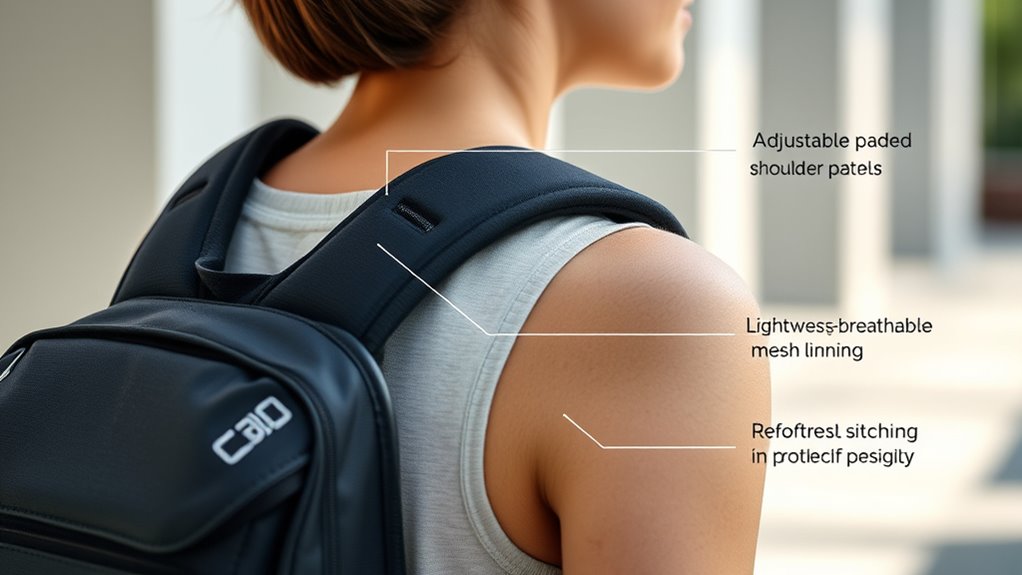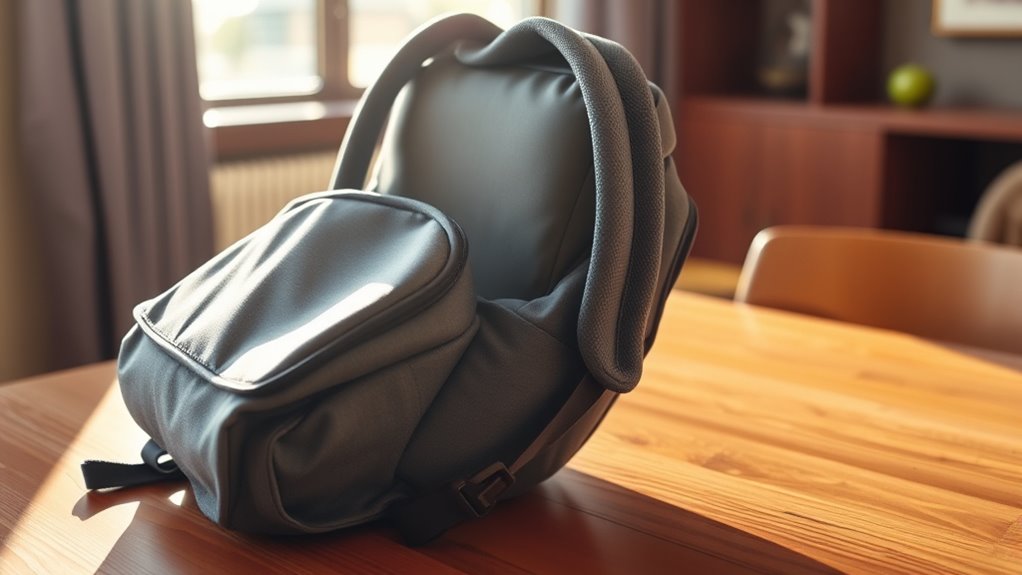To protect your posture, choose a bag with adjustable straps and padded support that fit your body comfortably. Look for even weight distribution features, like padded shoulder straps and back panels, which reduce pressure points and imbalance. Proper adjustment keeps the load close to your center of gravity, preventing strain. Ensuring your bag offers these ergonomic features helps maintain good posture and minimizes discomfort during extended wear—explore further to find the best options for your needs.
Key Takeaways
- Adjustable straps ensure a customized fit, keeping the bag close to the center of gravity and reducing strain.
- Padded shoulder straps and back panels distribute weight evenly, preventing pressure points and promoting good posture.
- Features like waist belts help stabilize the load, minimizing shifting and maintaining proper alignment.
- Even weight distribution across contact points reduces fatigue and supports spinal health during extended wear.
- Bag designs that promote a snug, balanced fit encourage correct posture and decrease the risk of musculoskeletal discomfort.

Have you ever wondered how the design of your bag affects your comfort and posture? The way your bag is built can make a huge difference in how you carry it throughout the day, influencing everything from muscle strain to spinal alignment. One of the most vital factors is weight distribution. When your bag’s weight is evenly spread across your shoulders and back, you’re less likely to experience discomfort or develop poor posture habits. A bag that concentrates weight in a small area can cause unnecessary pressure points, leading to fatigue and even pain over time. Look for designs that distribute weight across multiple contact points, such as padded shoulder straps, back panels, or waist belts, which help you maintain a balanced posture and prevent strain.
Proper bag design with balanced weight distribution and adjustable straps ensures comfort and supports good posture.
Equally important is strap adjustability. No two bodies are exactly the same, so having straps that can be customized to fit your body is essential. Adjustable straps allow you to set the bag at the right height and tightness, ensuring that the weight remains close to your center of gravity. When straps are too loose, the bag shifts, forcing your muscles to compensate for the imbalance, which can lead to awkward postures and muscle fatigue. On the other hand, straps that are too tight can restrict movement and cause discomfort. The ability to fine-tune strap length means you can keep the load stable and secure, reducing the risk of leaning forward or hunching over to compensate for an ill-fitting bag.
A well-designed ergonomic bag will also feature padded straps and back panels, which work together with strap adjustability to improve comfort. Padded straps distribute pressure more evenly across your shoulders, preventing soreness, while adjustable straps let you tailor the fit to your body’s shape and size. This customization ensures the bag sits snugly without digging into your skin or slipping out of place. When you can adjust straps easily, it encourages you to wear the bag correctly, with the weight centered and close to your spine, which is vital for maintaining good posture.
In essence, a bag with thoughtful weight distribution and strap adjustability actively protects your posture by enabling a comfortable, balanced fit. These features allow you to carry your belongings without putting undue stress on your muscles and joints. When shopping for a new bag, prioritize those with adjustable straps and evenly distributed weight features. Not only will it make your daily routine more comfortable, but it’ll also help you avoid long-term posture issues caused by poorly designed bags. Remember, the right ergonomic features make all the difference in how your body feels after a day of carrying your essentials.
Frequently Asked Questions
How Do I Choose a Bag Suited for Long-Term Daily Use?
To choose a bag suited for long-term daily use, focus on weight distribution and strap padding. Opt for a bag with adjustable straps that evenly distribute weight across your shoulders and back, reducing strain. Look for padded straps for extra comfort, especially if you carry heavy loads. Confirm the bag’s size fits your daily essentials without overstuffing. A well-designed ergonomic bag minimizes discomfort and supports good posture during extended wear.
Are There Specific Materials That Improve Ergonomic Support?
Choosing a bag with materials that improve ergonomic support means looking for durable fabrics like heavy-duty nylon or polyester, which withstand daily wear. Additionally, prioritize padding comfort in shoulder straps and back panels, as it reduces strain and enhances support. These features help maintain proper posture during long-term daily use, ensuring your bag stays comfortable and supportive over time.
Can Adjusting Straps Reduce Back Pain Effectively?
Yes, adjusting straps can effectively diminish back pain. When you customize strap adjustments, you distribute weight evenly across your shoulders and back, minimizing strain. Properly fitted straps keep the bag close to your body, improving balance and reducing unnecessary pressure on your spine. Regularly adjusting straps ensures your bag remains comfortable and supportive during use, helping you prevent back pain and maintain better posture throughout your day.
What Are Signs My Bag Is Causing Posture Issues?
In the words of a wise man, “A stitch in time saves nine.” If your bag causes shoulder or back pain, it might be due to excessive weight or inadequate strap padding. Signs include uneven posture, shoulder pain, or discomfort after carrying your bag. Pay attention to these cues, and consider adjusting the bag’s weight or strap padding to prevent further posture issues, ensuring your bag remains ergonomic and comfortable.
How Often Should I Replace My Ergonomic Bag?
You should replace your ergonomic bag every 1 to 2 years, especially if you notice increased bag weight or worn strap padding. Heavier bags strain your posture, so switching out your bag regularly helps prevent discomfort. Check for signs like frayed straps or decreased padding, which indicate it’s time for a new one. Regularly updating your bag ensures ideal support and keeps your posture protected during daily use.
Conclusion
Choosing the right bag isn’t just about style—it’s about safeguarding your posture. While a sleek design might catch your eye, prioritize features like padded straps and adjustable supports that protect your back. Remember, a fashionable bag that’s uncomfortable is like a beautiful painting with a crooked frame. So, balance looks with ergonomics, because your posture deserves as much attention as your outfit. Stay mindful, and carry with care—your body will thank you.







